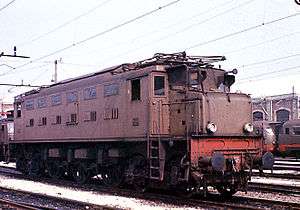FS Class E.326
FS class E.326
 |
| Type and origin |
|---|
| Power type |
Electric |
|---|
| Build date |
1930-1933 |
|---|
|
|
|
| Performance figures |
|---|
| Maximum speed |
140 km/h (87 mph), later limited
to 90 km/h (56 mph) |
|---|
| Power output |
2,100 kW (2,800 hp) |
|---|
|
| Career |
|---|
| Operators |
FS Trenitalia |
|---|
| Number in class |
12 |
|---|
| First run |
1930 |
|---|
| Disposition |
Decommissioned around 1983 |
|---|
|
The FS E.326 was a class of Italian railways electric locomotives. Designed in 1929, they were introduced in the early 1930s, for hauling passenger trains at relatively high speed.
History
The E.326 was part of family of locomotives designed in the 1920s and in 1930s for Italy's state railroad, which, through the use of a great number of standardized components, granted a short repair time of the frequent breakdowns. These included the E.428, designed for high mass trains, the E.626, for multipurpose roles, and the E.326, a smaller locomotive to be used for hauling lighter passenger trains.
During the tests the locomotives, having a nominal maximum output of 2,100 kW (2,800 hp), reached a top speed of 140 km/h (87 mph). This was obtained through the use of large traction wheels, inspired to those of the contemporary steam engines, and an extra-long gear ratio of 29/103. The choice of the 2-Co-2 wheel arrangement, having a 3-axle central rigid bogie with four trailing axles, caused reliability problems and caused in 1936 the reduction of the maximum speed allowed to 105 km/h (65 mph)).
In the course of World War II, all the 12 units produced were damaged by Allied bombings. They were repaired in the Foligno workshop (except with the 006, repaired at Bologna), and returned into service in 1949 with light modifications, including a new brown color scheme.
The maximum speed was further reduced to 90 km/h (56 mph) in the 1960s. The E.326s were retired from service starting in the 1970s, and demolished. Today only one unit survives, (E.326.004), preserved in the National Railroad Museum of Pietrarsa, near Naples.
References
- Mascherpa, Erminio (1993). Locomotive da corsa: storia del Gruppo E.326. Salò: Editrice Trasporti su Rotaie. ISBN 88-85068-06-5.
- Pocaterra, Renzo (2003). Treni. Novara: Istituto Geografico De Agostini.
 |
Wikimedia Commons has media related to FS E.326. |
